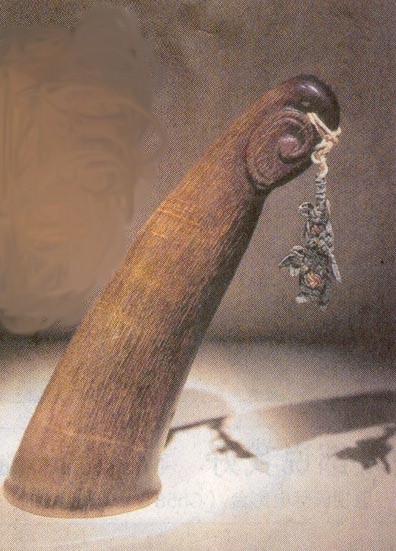|
Animal Spotlight
July 2003
Extremely Important Disclaimer to Note: The contents on this webpage are NOT intended to promote the appreciation, demand, trade or sale of rhino horn. This webpage is merely providing a rare insight to other uses of rhino horn, other than for Traditional Chinese Medicine (TCM ) and Jambias. Any of the above or other misunderstandings that could arise from viewing the following contents will be DEEPLY REGRETTED!! Hence, please treat the article as educational material and read with an opened mind. Lastly, please control your emotions at ALL times!
WARNING! If you possess a weak heart and strongly oppose the use of endangered animal parts, regardless of whether they are relics of the past or what ever, please refrain from reading further for the sake of your emotional well-being. However, if you are clear of these symptoms, you may proceed.
Rhino Horn Carvings Article taken from the Arts section of Lian He Zao Bao dated 4 July 2003.
There are no wild rhinos in China today, however the Middle Kingdom has long been well known for its rhino horn carvings. This involved transforming raw and whole pieces of rhino horns into stunning cups, then adding intricate designs onto them. Upon hearing the mention of rhino horn, one would inevitably be reminded that rhinos are supposedly highly endangered animals and they are now protected under strict international laws. Hence, the hunting and killing of these massive beasts are illegal. How is it possible to obtain their horns to carve into products? Thankfully, the items on display are from the Ming and Qing Dynasties, and every piece is at least 5 to 6 hundred years old by now! These days, no one carves rhino horns anymore. Besides, current statistics show that only around 14,000 rhinos are left in the wild throughout the world. Rhinos are huge, bulky mammals and are herbivorous by nature. They have a low productive rates to start with, and together with habitat destruction and senseless poaching, these caused the world's populations to plummet rapidly. Currently, wild rhinos can only be found in northern India, Indonesia and Africa.
Collectors' Items from the 12th to 18th Centuries According to Mr. Tan, the Curator of the Asian Civilisation Museum, the items on display belong to a pair of local father and son collectors - Senior and Junior Chiu. Senior Chiu spent his early years living in Shanghai, Hong Kong and has passed away since 1980. He started collecting rhino horn carvings since 1959. Junior Chiu inherited his father's hobby and the latter now owns over 60 pieces of these prized items. The oldest piece dates back to the 12th century! Most of the collection date between the 16th to 18th centuries. According to Junior Chiu, the chemical composition in rhino horn can change over a very long period of time. Horns that are centuries old could even develop a jade-like luster.
According to Mr. Tan, rhinos did exist in ancient China, especially before the Qin (221 BC - 206 BC) and Han (206 BC - 220 AD) Dynasties, Then, rhinos could be found from the plains of northern China to the Jiangnan region in southern China. Back then, the ancient Chinese used rhino hide to make armours, and the horns as cups and powdered medicines. Later, overhunting and climatic changes led to the eventual extinction of rhinos in China. However, the art of rhino horn carving lived on and was passed through the generations, mainly relying on stock supplied by foreign traders. Centuries later, rhino horn was even imported by sea from southeast Asia. The peak of rhino horn carving was mainly during the Ming (1368 AD - 1644 AD) and Qing (1644 AD - 1911 AD) Dynasties, especially in the provinces of Suzhou, Yangzhou and Hangzhou. During the late Qing Dyansty, China's government became weak, and coupled with dwindling overseas supplies, the art eventually died out. (Right: Inverted rhino horn cup - 17th century) Rhino horn in TCM In TCM, rhino horn is believed to contain properties that cure fever, neutralize poison and dispel heat (from body), a valuable medicine indeed. (of course we all know today that rhino horn is basically keratin, typical fingernail and hair material of any living creature). Drinking from rhino horn cups was even believed to strengthen the human body because the chemical properties present in the horn would dissolve into the drink each time the cup was used.
The complexities of carving rhino horns
Above: Lotus flower design with jade-like luster. Some craftsmen cut off the tips and used them to shape the base of the cups. Or they cooked the horns till they were soft enough to manipulate into the desired shapes. The softened horns were then allowed to cool and harden before carving designs on their exteriors. (see below)
Lotus design rhino horn cup.
Just in case anyone is interested to know the timelines of the dynasties of ancient China (lifted off an online Chinese history textbook): Xia
(21st Century BC - 16th Century BC)
Acknowledgements - Contents of the above were directly translated from Lian He Zao Bao dated 4 July 2003. Pictures from the same the article. NOTE: The disclaimer and warning at the top of this page can be taken either seriously and light heartedly. Some readers unfortunately, can become distressed from reading too deeply into such articles.
Back to
Home | Explore | Rangers’ Station | Walking Trails | Tram Ride | Resources
|


 How
did rhino horn carving begin in China?
How
did rhino horn carving begin in China?